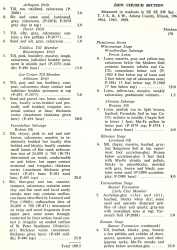Loveland Silt
Lithostratigraphy: Wedron Group >>Loveland Silt
Chronostratigraphy: Cenozoic Erathem >>Quaternary System >>Pleistocene Series
Primary source
Willman, H. B., and John C. Frye, 1970, Pleistocene Stratigraphy of Illinois: Illinois State Geological Survey Bulletin 94, 204 p.
Contributing author(s)
H. B. Willman and John C. Frye
Name
Original description
Loveland joint clay (Shimek 1909).
Derivation
The Loveland Silt was named for Loveland, Iowa, from deposits in the bluff of the Missouri River Valley east of the town.
Other names
History/background
Type section
Type location
The type locality is listed by Kay and Graham (1943, p. 64) as Sec. 3, Rockford Township, T. 77 N., R. 44 W., Pottawattamie County, Iowa. The Loveland Silt is described in the Cache, Gale, and Zion Church Sections (table 6).
| Table 6 -- Stratigraphic Sections (partial) The following 21 stratigraphic sections describe exposures in Illinois and illustrate many of the aspects of Pleistocene stratigraphy. These sections contain the type localities for 21 rock-stratigraphic units, 4 soil-stratigraphic units, and 3 time-stratigraphic units and include paratypes for several other units. The sample numbers preceded by "P" are the numbers used in the Illinois State Geological Survey collections. Analytical data on many of these samples are on file at the Survey. The sections are arrange alphabetically by name. |
Type author(s)
Type status
Reference section
Reference location
Reference author(s)
Reference status
Stratigraphic relationships
The Loveland Silt occurs stratigraphically above the Kansan Till and below loess now correlated with the Roxana. Kay and Graham (1943) reviewed the history of the term and its expansion to include the sand and gravel deposits below the silt. Lugn (1935) restricted the Loveland Formation to the silts above his "Upland" Formation and below the loess of his Peorian Formation. Condra, Reed, and Gordon (1950) restricted the Loveland Formation of Nebraska, across the Missouri Valley from the type section, to the silts above the waterlaid sands and gravels and below the Peorian Loess. Frye and Leonard (1951) assigned the silts and sands above the outwash gravels to the Loveland, and Reed and Dreeszen (1965) restricted the Loveland Loess of Nebraska to the uppermost Illinoian silt deposits.
In Kansas, the term Loveland Member of the Sanborn Formation (Frye and Leonard, 1952) was applied to the silts and loess above the Yarmouth Soil that are terminated at the top by the Sangamon Soil. In Illinois, the term Loveland Loess was applied by Leighton and Willman (1950) to the loess at the base of the Illinoian sequence (now Petersburg Silt), as well as to the silts beyond the limit of Illinoian glaciation, but Frye and Willman (1960) restricted the Loveland Silt to the undifferentiated silts of Illinoian age beyond the Illinoian glacial limit, with its lower boundary the top of the Yarmouth Soil and the upper boundary the top of the Sangamon Soil. The Loveland Silt is classified here as a formation.
Extent and thickness
The spatial relations of the Loveland are shown diagrammatically in figure 7. The silts intercalated with the tills of Illinoian age are separately named and described, and the Loveland is terminated by vertical cutoff.
In Illinois the Loveland Silt is widespread as the basal unit of the loess sequence in the unglaciated areas of extreme southern Illinois, in Calhoun County and parts of Pike and Jersey Counties in western Illinois, in northwestern Illinois, and also in the area of Kansan glaciation in western Illinois (pl.2). In these areas it is a distinctive red or red-brown silty clay or clayey silt, commonly 2 to 4 feet thick but absent or only locally present in many exposures.
Lithology
Shimek described the deposit as reddish to yellowish silt and clay.
Core(s)
Photograph(s)
Contacts
Well log characteristics
Fossils
Age and correlation
Environments of deposition
Although it locally contains sheetwash and alluvial silts, the major part of the Loveland is judged to be an eolian deposit.
Economic importance
Remarks
References
CONDRA, G. E., E. C. REED, and E. D. GORDON, 1950, Correlation of the Pleistocene deposits of Nebraska: Nebraska Geological Survey Bulletin 15A, 74 p.
FRYE, J. C., and A. B. LEONARD, 1951, Stratigraphy of the late Pleistocene loesses of Kansas: Journal of Geology, v. 59, no. 4, p. 287-305.
FRYE, J. C., and A. B. LEONARD, 1952, Pleistocene geology of Kansas: Kansas Geological Survey Bulletin 99, 230 p.
FRYE, J. C., and H. B. WILLMAN, 1960, Classification of the Wisconsinan Stage in the Lake Michigan Glacial Lobe: Illinois State Geological Survey Circular 285, 16 p.
KAY, G. F., and J. B. GRAHAM, 1943, The Illinoian and post-Illinoian Pleistocene geology of Iowa: Iowa Geological Survey, v. 38, p. 1-262.
LEIGHTON, M. M., and H. B. WILLMAN, 1950, Loess formations of the Mississippi Valley: Journal of Geology, v. 58, no. 6, p. 599-623. (Reprinted as Illinois State Geological Survey Report of Investigations 149)
LUGN, A. L., 1935, The Pleistocene geology of Nebraska: Nebraska Geological Survey Bulletin 10, 213 p.
REED, E. C., and V. H. DREESZEN, 1965, Revision of the Classification of the Pleistocene Deposits of Nebraska: Nebraska Geological Survey Bulletin 23, 65 p.
ISGS Codes
| Stratigraphic Code | Geo Unit Designation |
|---|---|





